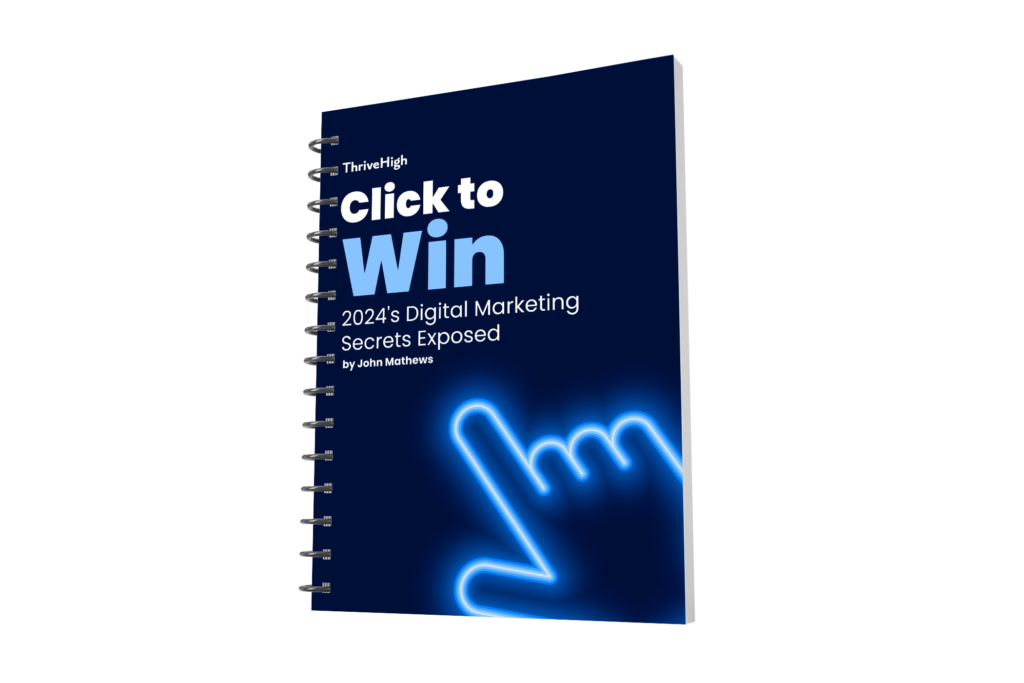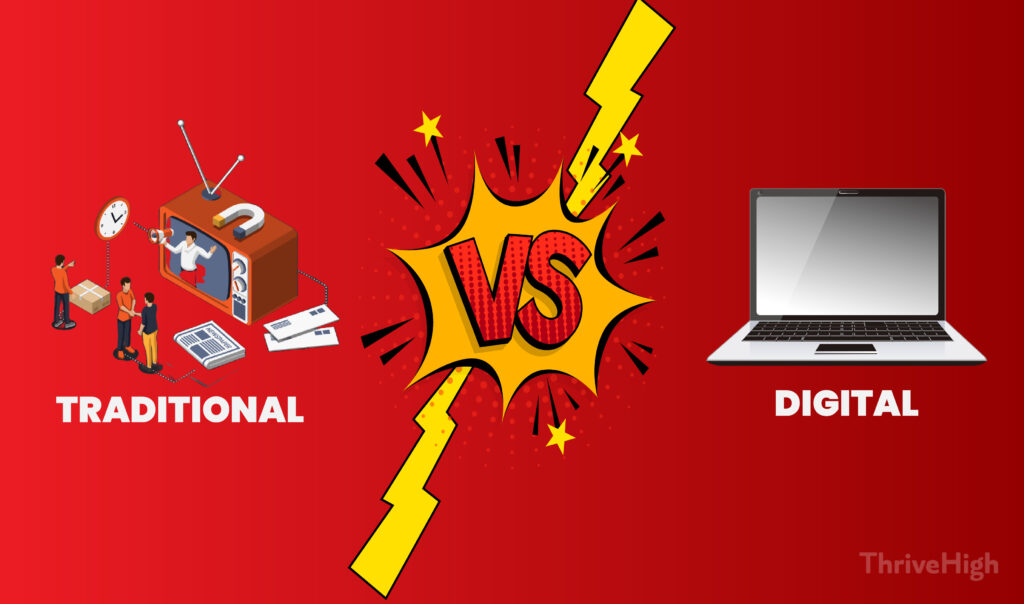Introduction
There are many ways to capture the audience’s attention. Marketing is one of the most fundamental things in a business, as it helps obtain people’s attention. There are two methods of marketing. One is traditional marketing, a classical type of marketing, In the realm of marketing, there’s an age-old debate that continues to stir the waters of business strategy: digital marketing versus traditional marketing. While both methods serve the fundamental purpose of capturing audience attention and driving sales, they differ significantly in their approach and execution.
It involves understanding customer needs and desires, creating offerings that meet those needs, and communicating the value of those offerings effectively. The goal of marketing is to attract, retain, and satisfy customers while generating revenue and achieving organizational objectives. It involves identifying target markets, segmenting them based on demographics, psychographics, or behavior, and positioning products or services to appeal to specific segments.
What is Traditional Marketing?
Traditional marketing refers to conventional methods of promoting and advertising products or services that were used before the digital age. It includes offline channels such as television, radio, print media (newspapers, magazines), outdoor advertising (billboards, posters), direct mail, and telemarketing. Traditional marketing typically involves reaching a broad audience through mass media channels and relies on tangible materials or physical interactions. While traditional marketing has been a staple in the industry for decades and can still be effective, it often lacks the precise targeting and real-time analytics offered by digital marketing methods.
Why Traditional Marketing?
Traditional marketing continues to be relevant for several reasons:
Wide Reach: Traditional marketing methods like television, radio, and print media have the potential to reach a broad audience, making them suitable for businesses aiming to generate brand awareness on a large scale.
Tangible Presence: Print ads, billboards, and direct mail provide a physical presence that can leave a lasting impression on consumers, especially those who prefer tangible marketing materials.
Established Credibility: Traditional marketing methods have a sense of credibility and authority associated with them, as they’ve been relied upon for decades by businesses of all sizes. This can be particularly important for industries where trust and reputation are paramount.
Targeting Certain Demographics: While digital marketing allows for precise targeting, traditional methods can still be effective for reaching specific demographics that are more likely to engage with traditional media channels.
Go From Beginner to Expert in
Just 8 Months!
With Purdue PG Digital Marketing Program
Forms of Traditional Marketing
Traditional marketing encompasses various offline methods of promoting products or services to a target audience. Some common forms of traditional marketing include:
Television Advertising: Commercials aired on television networks to reach a wide audience. Television advertising allows for visual and auditory storytelling to convey a message effectively.
Radio Advertising: Advertisements broadcasted over radio stations to reach listeners during specific timeslots or programs. Radio advertising relies on audio content to engage with audiences.
Print Advertising: Promotional content published in print media such as newspapers, magazines, flyers, brochures, and posters. Print advertising allows for visually appealing layouts and targeted distribution.
Trade Shows and Events: Participating in industry-specific trade shows, exhibitions, conferences, and events to showcase products or services to attendees. Trade shows and events offer opportunities for face-to-face interactions and networking.
Word-of-Mouth Marketing: Encouraging satisfied customers to spread positive recommendations and referrals to friends, family, and colleagues. Word-of-mouth marketing relies on personal endorsements to build trust and credibility.
Integrating both traditional and digital marketing strategies can create a comprehensive approach to promoting products or services and achieving marketing objectives. When considering digital marketing versus traditional marketing, businesses must assess the strengths and weaknesses of each approach and determine the most effective combination based on their target audience, industry, and marketing goals.
What is Digital Marketing?
Digital marketing versus traditional marketing refers to the comparison between modern online advertising techniques and conventional offline promotional methods. Digital marketing harnesses the power of the internet and digital platforms to reach target audiences, while traditional marketing relies on offline channels like print, television, and radio. In the digital age, businesses must weigh the benefits and drawbacks of each approach to determine the most effective strategy for their marketing efforts. While digital marketing offers precise targeting, real-time analytics, and interactive engagement, traditional marketing methods often provide broad reach and tangible brand presence. Understanding the nuances between digital marketing versus traditional marketing is essential for crafting successful marketing campaigns in today’s competitive landscape.
Why Digital Marketing?
In the ongoing debate between digital marketing versus traditional marketing, the merits of each approach are scrutinized in the quest for effective promotional strategies. Digital marketing harnesses the power of the internet and digital platforms to reach target audiences with precision targeting, real-time analytics, and interactive engagement. In contrast, traditional marketing relies on offline channels like print, television, and radio, offering broad reach and tangible brand presence. Understanding the nuances between digital marketing versus traditional marketing is essential for crafting successful marketing campaigns in today’s competitive landscape and determining which approach aligns best with business objectives and target audience preferences.
Forms of Digital Marketing

Digital marketing encompasses a wide range of tactics and strategies to promote products or services using digital channels. Some common forms of digital marketing include:
Search Engine Optimization (SEO): Optimizing website content and structure to improve visibility in search engine results pages, thereby increasing organic (non-paid) traffic.
Social Media Marketing: Using social media platforms such as Facebook, Instagram, Twitter, LinkedIn, and Pinterest to promote products or services, engage with audiences, and build brand awareness.
Content Marketing: Creating and distributing valuable, relevant, and consistent content to attract and retain a target audience. This can include blog posts, articles, videos, infographics, and more.
Email Marketing: Sending targeted messages or newsletters to a list of subscribers to promote products, services, or special offers. Email marketing can also be used to nurture leads and build customer relationships.
Affiliate Marketing: Partnering with other businesses or influencers to promote products or services in exchange for a commission on sales generated through referral links or codes.
Influencer Marketing: Collaborating with individuals or influencers with a large and engaged following on social media to endorse products or services and reach their audience.
PPC – Pay-per-Click: These are paid advertisements. They only stay on the web for a shorter period. Once you stop paying, it will be gone.
Mobile Marketing: Targeting users on mobile devices through channels such as mobile apps, SMS (text messaging), and mobile-responsive websites.
These are just a few examples of the many forms of digital marketing available to businesses. Each form offers unique opportunities to connect with target audiences, drive engagement, and achieve marketing objectives in the digital realm. Each form offers unique opportunities to connect with target audiences, drive engagement, and achieve marketing objectives in the digital realm. When considering digital marketing versus traditional marketing, businesses must weigh the benefits and limitations of each approach to determine the most effective strategy for reaching their goals.
Pros and Cons of Traditional Marketing:
Traditional marketing, encompassing methods such as print, television, radio, and billboards, has long been a staple in the promotional toolkit of businesses worldwide. Understanding its pros and cons is crucial for crafting effective marketing strategies.
Pros:
Tangible Presence: Traditional marketing offers a tangible presence, with print materials and billboards physically reaching consumers in their daily lives, potentially leaving a lasting impression.
Wide Reach: Methods like television and radio advertising can reach a broad audience, making them suitable for generating brand awareness on a large scale.
Established Credibility: Traditional marketing methods have a sense of credibility and authority associated with them due to their longstanding use in the industry.
Go From Beginner to Expert in
Just 8 Months!
With Purdue PG Digital Marketing Program
Cons:
Limited Targeting: Traditional marketing lacks the precise targeting capabilities of digital marketing, often reaching a broad audience that includes many who may not be interested in the product or service.
Cost-Intensive: Advertising through traditional channels can be costly, requiring significant investments for production, placement, and distribution.
Difficult Measurement: Tracking the effectiveness of traditional marketing campaigns can be challenging, with less accurate metrics and insights compared to digital marketing.
Traditional marketing methods have their advantages, they also come with limitations that businesses must consider when devising their marketing strategies. Integrating traditional marketing with digital approaches can create a comprehensive strategy that maximizes reach and impact in today’s competitive landscape.
Pros and Cons of Digital Marketing
Digital marketing has revolutionized the way businesses promote their products and services in the modern era. Understanding its advantages and disadvantages is essential for creating effective marketing strategies.
Pros:

Global Reach: With the internet as its foundation, digital marketing offers global reach, allowing businesses to connect with audiences worldwide regardless of geographical boundaries.
Interactive Engagement: Digital marketing enables interactive engagement with consumers through social media, email, and other online channels, fostering two-way communication and building stronger relationships with customers.
Cost-Effective: Compared to traditional marketing methods, digital marketing can be more cost-effective, with options for flexible budgeting and the ability to reach large audiences at a lower cost per impression.
Real-Time Analytics: Digital marketing platforms provide detailed analytics and insights in real-time, allowing businesses to track the performance of their campaigns and make data-driven decisions to optimize results.
Cons:
Privacy Concerns: Digital marketing relies on collecting and analyzing user data, raising privacy concerns among consumers and increasing scrutiny over data handling practices.
Ad Blocking: The prevalence of ad-blocking software poses a challenge to digital marketing efforts, as it can prevent advertisements from reaching intended audiences.

